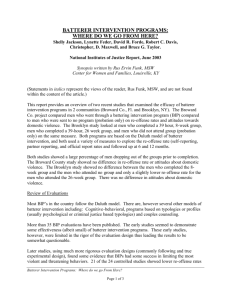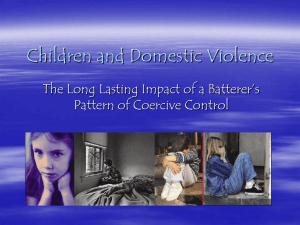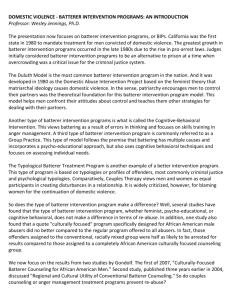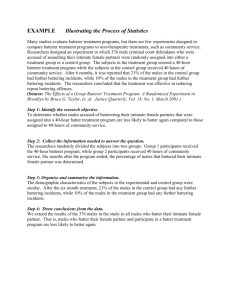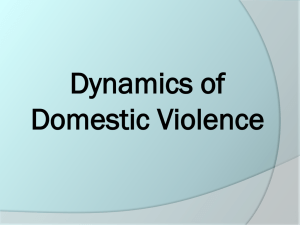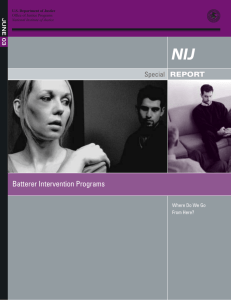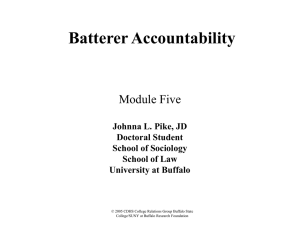domestic violence - examples of batterer intervention programs
advertisement
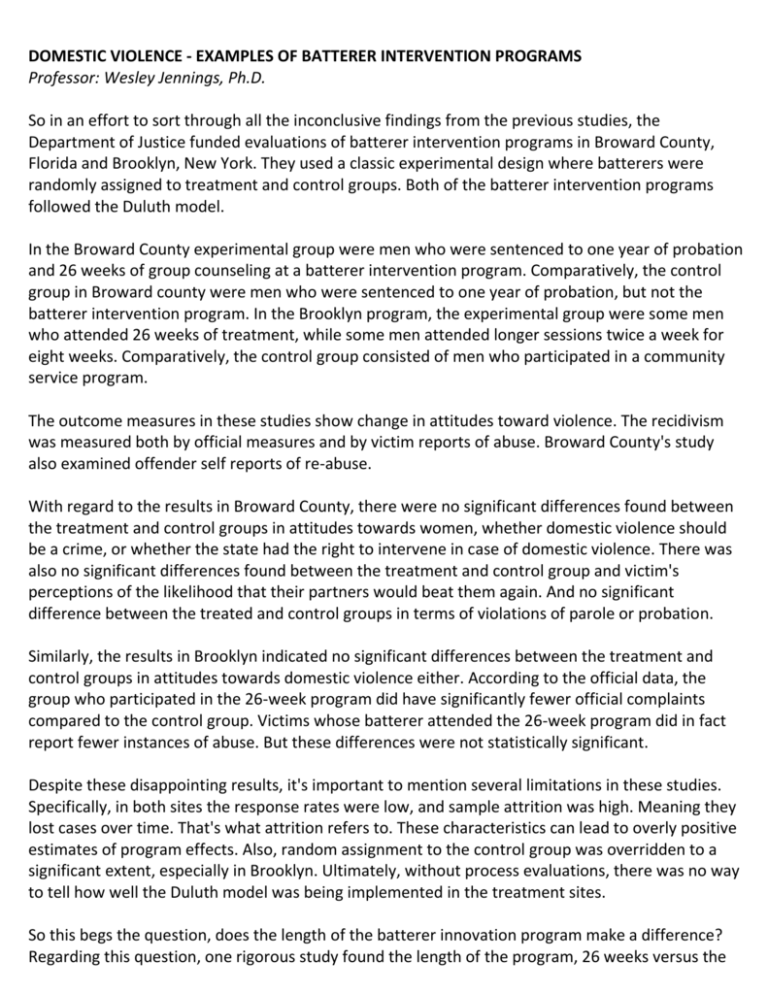
DOMESTIC VIOLENCE - EXAMPLES OF BATTERER INTERVENTION PROGRAMS Professor: Wesley Jennings, Ph.D. So in an effort to sort through all the inconclusive findings from the previous studies, the Department of Justice funded evaluations of batterer intervention programs in Broward County, Florida and Brooklyn, New York. They used a classic experimental design where batterers were randomly assigned to treatment and control groups. Both of the batterer intervention programs followed the Duluth model. In the Broward County experimental group were men who were sentenced to one year of probation and 26 weeks of group counseling at a batterer intervention program. Comparatively, the control group in Broward county were men who were sentenced to one year of probation, but not the batterer intervention program. In the Brooklyn program, the experimental group were some men who attended 26 weeks of treatment, while some men attended longer sessions twice a week for eight weeks. Comparatively, the control group consisted of men who participated in a community service program. The outcome measures in these studies show change in attitudes toward violence. The recidivism was measured both by official measures and by victim reports of abuse. Broward County's study also examined offender self reports of re-abuse. With regard to the results in Broward County, there were no significant differences found between the treatment and control groups in attitudes towards women, whether domestic violence should be a crime, or whether the state had the right to intervene in case of domestic violence. There was also no significant differences found between the treatment and control group and victim's perceptions of the likelihood that their partners would beat them again. And no significant difference between the treated and control groups in terms of violations of parole or probation. Similarly, the results in Brooklyn indicated no significant differences between the treatment and control groups in attitudes towards domestic violence either. According to the official data, the group who participated in the 26-week program did have significantly fewer official complaints compared to the control group. Victims whose batterer attended the 26-week program did in fact report fewer instances of abuse. But these differences were not statistically significant. Despite these disappointing results, it's important to mention several limitations in these studies. Specifically, in both sites the response rates were low, and sample attrition was high. Meaning they lost cases over time. That's what attrition refers to. These characteristics can lead to overly positive estimates of program effects. Also, random assignment to the control group was overridden to a significant extent, especially in Brooklyn. Ultimately, without process evaluations, there was no way to tell how well the Duluth model was being implemented in the treatment sites. So this begs the question, does the length of the batterer innovation program make a difference? Regarding this question, one rigorous study found the length of the program, 26 weeks versus the eight week program, did make a difference, with the longer program proving more effective at deterring reabuse. Also, the researchers suggest that the longer program's increased effectiveness was largely due to its longer suppression effect while its users were mandated to attend. In a sense, they were under supervision longer in the program, thereby reducing their likelihood of reabusing their victims. However, regarding the length of the batterer intervention program perhaps making a difference, another multi-state study of four batterer intervention programs with varying lengths from three months to nine months found no statistically significant differences in subsequent rates of reabuse, at least according to official data. So it's important to compare the characteristics of those who complete batterer intervention programs compared to those who fail to complete the batterer intervention programs. Abusers who complete batterer intervention programs are less likely to reabuse than those that fail to attend, are not compliant, or drop out of the batterer intervention programs. These differences can be substantial. For example, a study in Chicago of more than 500 court-referred batterers referred to 30 different programs found that program completers' recidivism after an average of 2.4 years was only 14% compared to non-completer rates were more than twice as high, with a recidivism rate of 35%. Similarly, a Massachusetts study found that the rate differences between completers and noncompleters was 48% versus 84% for any crime, 34% versus 64% for crimes of violence specifically, and 17% versus 42% for violations of a protective order. In addition, a study in Dallas found that twice as many program dropouts were rearrested within 13 months compared to those who completed the batterer intervention programs. Specifically, 40% rearrest versus 18% for any charge, and 8% versus 3% for assault arrest specifically. In another study conducted in Alexandria, Virginia of almost 2,000 domestic violence defendants found that noncompliance with court-ordered treatment was significantly related to being a repeat offender. However, the study also found reduced reabuse rates for completers. Several other studies have found the reductions to be less dramatic. Specifically, the Broward County analysis found the difference to be only 4% versus 5%. And the Brooklyn analysis found the difference in reabuse to be 16% versus 26%. So the implications from this body of research are that compliance with mandated batterer intervention programs provide judges with a dynamic risk instrument based on defendants' ongoing behavior. In other words, reabuse can be reduced if the courts respond appropriately and expeditiously to batterers who fail to attend or who are found in noncompliance with the courtreferred batterer intervention program. Several studies have found that batterers who do not complete batterer intervention programs are likely to be non-compliant from the start. Furthermore, it has been found that noncompliance at the first court monitoring session significantly predicts both program failure and recidivism. Specifically, in the Brooklyn study for example, the strongest predictor of program failure was early noncompliance. In other words, defendants who had not enrolled in a program by the time of their first compliance hearing were significantly less likely to complete the program compared to those enrolled by the first hearing. These findings are similar to those found in the Bronx. Specifically, defendants who were not in compliance at their first monitoring appearance were six times more likely to fail to complete the program compared to those in compliance at that particular time. These findings are consistent with extensive research, indicating that the large proportion of courtidentified abusers who reabuse are likely to do so sooner rather than later. Overall, in an effort to safeguard victims, courts should respond immediately to an abuser's first failure to enroll or attend a court-mandated batterer intervention program in order to prevent reabuse. Batterer program attendance rates can also be increased by court monitoring, and specifically through periodic court compliance hearings. For example, in a multi-state evaluation of four batterer intervention programs, researchers found that batterer completion rates rose from under 50% to 65% after the courts introduced a mandatory appearance 30 days after offenders were mandated to attend the batterer intervention program. In a large Massachusetts study, defendants were ordered to attend programs as a condition of probation, had completion rates of 62% compared to those who were ordered to attend the program without probation supervision, who had completion rates of only 30%. In another study of three domestic violence courts in the state of Michigan, Wisconsin, and Massachusetts found significantly increased offender compliance with batterer intervention programs, both in showing up in general and staying enrolled in the program. And the evidence suggested that all three courts featured post-dispositional review hearings. In an effort to increase program participation, prosecutors should recommend offenders have postdispositional compliance hearings, as well as placing abusers on supervised probation. However, overall limited research has been conducted on this issue. But none suggest that increased judicial monitoring does anything but increase attendance. So what are some potential new alternatives to batterer intervention programs? Some scholars suggest that domestic violence initiatives could benefit from reflecting on current approached used with drug offenders. For example, the increasingly popular drug court model involves a combination of judicial supervision and community-based treatment in an effort to encourage and promote recovery. Judicial supervision encompasses regular court appearances, direct and often extensive incourt interaction between the judge and the defendant, and the use of judicial rewards and sanctions. Many drug courts have elaborate formal response schedules for defendants that spell out the sanctions and rewards that will be imposed in response to various infractions. This model differs though from popular approaches with misdemeanor domestic violence offenders because the dosage of the intervention is exponentially greater. The judicial supervision component in drug courts is far more developed compared to the monitoring in most domestic violence court settings. So overall, batterer intervention programs in and of themselves are not likely to protect most victims. Consequently, if mandated, batterer intervention programs should be supplemented by other measures in an effort to assure victim safety.

